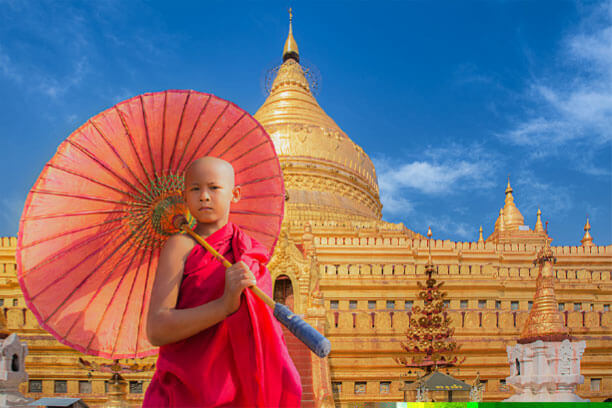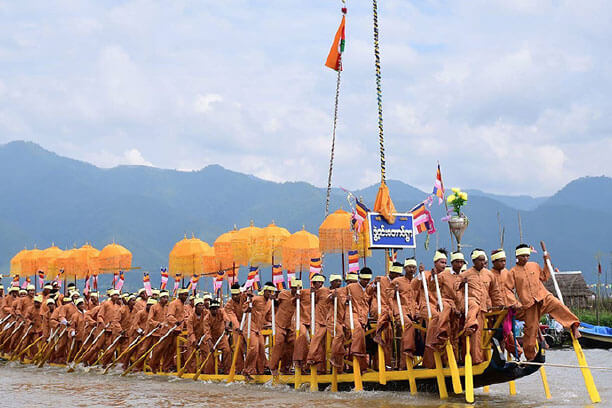
Myanmar offers an impressive blend of culture and modern life. Unique music, dance, exciting festivals, delicious food, and beautiful traditional crafts along the cities bustling with activities define the way of life in this exciting and unexplored South Asian country.
Myanmar has been at the cultural crossroads of Asia where amalgamation of ideas went hand in hand with exchange of material, giving rise to a distinctive cultural identity to the country. Buddhism, with its origin in India, found its way into Myanmar in the 1st Century CE and blended well with pre-existing non-Buddhist beliefs. The splendid architecture and sculpture of Myanmar’s numerous temples and monasteries, notably those at Yangon, Mandalay, and Bagan, the site of the ancient kingdom of west-central Myanmar, bears the testimony of Myanmar’s cultural richness, that has been surprisingly preserved in its pristine form even today.
Among Myanmar’s most prominent cultural institutions are the state schools of dance, music, drama, and fine arts at Yangon and Mandalay, as well as the National Museum of Art and Archaeology at Yangon. There also is an archaeological museum at Pagan. A number of other museums focus on state and regional history.

MUSIC
Music has a deep influence on the life of farmers in rural areas, as the traditional Myanmar music was created to accompany the agricultural activities. Myanmar traditional music can be found in the worshipping of pagoda festival and weeding ceremonies.

There are historical evidences for the use of at least five basic musical instruments – kyey (Bronze), kyo (string), thayey (Skin of Hide), lei (wind) and let kup (clapper) – in Myanmar’s performing arts. These five musical instruments are widely known and used till today.
Softer instruments commonly heard in nontheatrical indoor settings, such as the saung gauk (harp) and pattala (bamboo xylophone), typically accompany singing from a compendium of Burmese songs called Mahagita (“Great Music”). Since colonial times, musicians of Myanmar also have incorporated various instruments of Western origin into their indigenous musical traditions, reworking the instruments’ sound, repertoire, and playing technique to reflect local aesthetics. For example, a significant repertoire of music has been developed for the piano, locally called sandaya, that is stylistically evocative of the circle of tuned drums, the harp, and the xylophone.
In Myanmar, the instrumental performance is not subservient to singing. The instrumental performances are of equal importance by agreement. One characteristic of Myanmar music is that through the length and breadth, there is no depth. Since Myanmar musical instruments are not constructed with harmony in mind, they are confined to producing melody so that audiences can listen to appreciate it.
The various pwe, the most popular dramatic form of dance, are accompanied by music of the hsaing waing, a percussive instrumental ensemble with close relatives in neighbouring countries of mainland Southeast Asia. The leading instruments in the hsaing waing include a circle of 21 tuned drums called pat waing, an oboelike hne, a circle of small, horizontally suspended tuned gongs known as kyi waing, and another set of small gongs called maung hsaing. These instruments are supported melodically by other gongs and drums, while a wooden block and a pair of cymbals set the tempo and reinforce the musical structure.
DANCE
Myanmar dance patterns are moving, waving, bending and twisting of head, fingers, elbows and shoulders in circular movements and postures. The legs are doubled up, extended and turned in the same tentacular manner while the body bends and winds in any direction. All the body parts mentioned above move with ease and flexibility. In short, Myanmar dance consists of posturings which slow or quick movements in between them.
Dance styles that are accompanied by hsaing waing are derived in part— and indirectly—from southern India. Much of the Burman dance tradition was adapted from the styles of Thailand and other “Indianized” (or formerly Indianized) states of Southeast Asia, especially during the 18th century. The most popular dramatic form pwe is performed outdoors. There are a variety of pwe genres, including both human and puppet theatre, and most draw subject matter from the Jataka tales—stories of the former lives of the Buddha.
Also Read: India-Myanmar a progressive partnership
Archaeological evidences show that Myanmar dance forms have been firmly established in Pyu period, AD 1 to 9. Five bronze figures seemingly a troupe of doebat (doubled headed drum) dancers accompanied with the music of flute, cymbal and double-headed drum has been traced to this period.
TRADITIONAL ARTS AND DESIGN
Myanmar is famous for its traditional arts and design. The art work designs in Myanmar can be seen across the country. Wood carving, lacquerwork, goldwork, silverwork, and the sculpting of Buddhist images and mythological figures also survived during colonial rule; there has been a revival of these and other indigenous art traditions under government patronage. Both the arts of bronze casting among the Burmans and of making bronze drums among the Karen and Shan, however, disappeared. The cinema and rock based popular music are two international art forms that have been accepted into the cultural life of Myanmar.
Myanmar possesses ten traditional arts, called pan se`myo: Blacksmith, woodcarving, goldsmith, stucco relief, masonry, stone carving, turnery, painting, lacquer ware and bronze casting.
Also Read: Travellers’ guide to fascinating Myanmar
Amongst traditional arts and designs, Tapestry (Shwe Chi Hto) is also significant in Myanmar. It originated in the country about thousand years ago. Tapestry is a creation of a variety of picture and patterns with a needle work including with gold thread to become delicate and detailed pictures. This form of art and design requires the best artistry skill and patience.
Myanmar traditional puppetry is a famous manifestation of the traditional arts and design where, 28 main characters are composed of puppets, ranging from Gods, animals, royals, actors and actresses. The Myanmar traditional puppets are usually made with wooden pieces including 17 to 19 pieces attached together with 11 to 16 strings.
LITERATURE & MEDIA
Myanmar’s literature is an intimate blend of religious and secular genres. It remained alive throughout the colonial period and, in both verse and prose, has continued to thrive. A later (though not entirely new) development was biography, which has become more popular than fiction. Government-sponsored awards are given annually for the best translation, the best novel, and the best biography.
The government-operated Myanma TV and Radio Department has television programming in Burmese and Arakanese and radio programming in Burmese, English, and a number of local languages. Some foreign radio services—most notably Voice of America and the British Broadcasting Corporation (BBC)—are an important source of international as well as domestic news.
CUISINE
The staple food for Myanmar people is rice and curry. Most of the curries are spicy and sour. Myanmar is also distinct as a country of sea food as Myanmar has long coast line.
Myanmar Cuisine, a result of fertile agricultural land, draws heavily on natural fruits, vegetable and fish. Fermented salted fish (Ngapi) associated with the Myanmar people, is used to flavour many Myanmar dishes which are simply but spicy with ingredients.
Also Read: Myanmar- The Golden Land
Mohinga is the famous traditional food of Myanmar. It is a kind of fish soup and is served together with rice noodle. The fish soup is composed of soft banana stems, onions, beans, ginger, lemon grass as well as spicy ingredients.
Ohn-noh-Kauk Swel (coconut noodle) is also famous in Myanmar. It is a soup made of coconut milk, onion, beans and chicken. The soup is served with the flour noodle. Both Mohinga and Ohn-noh-kaukswel can be served as breakfast. Both these soups also find place on social and religious occasions.
The pickle tea leaf salad (laphetthoke) is a famous and typical food of Myanmar. The salad is served either with meal or as a dessert. The ingredients are pickle tea leaves, fried beans, sesame seeds, fried garlic, oil, chili, sliced tomatoes and dry prawns. The ingredients are mixed together to serve as a salad.
Be a part of Elets Collaborative Initiatives. Join Us for Upcoming Events and explore business opportunities. Like us on Facebook , connect with us on LinkedIn and follow us on Twitter, Instagram.











